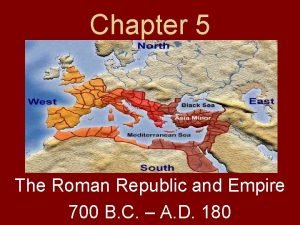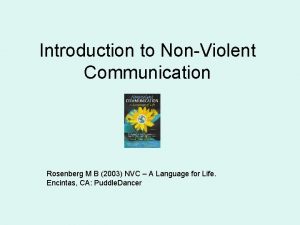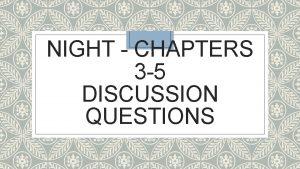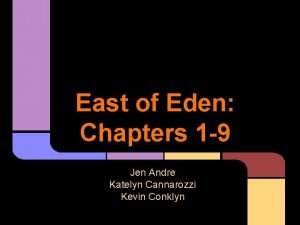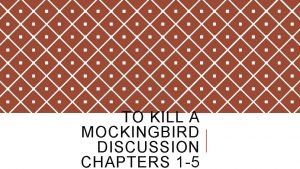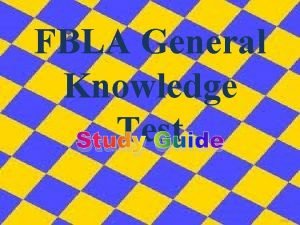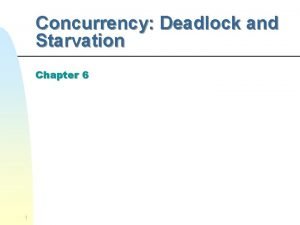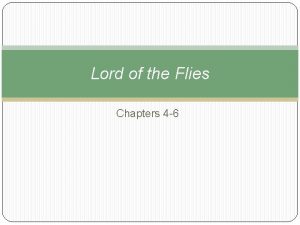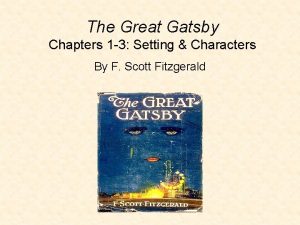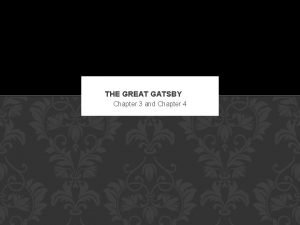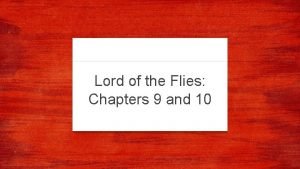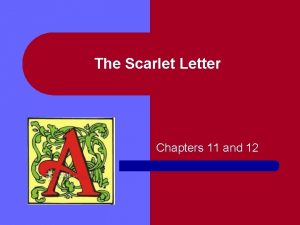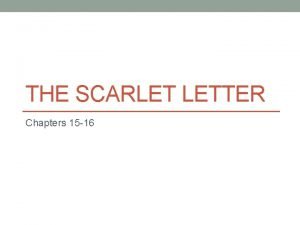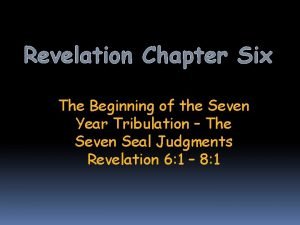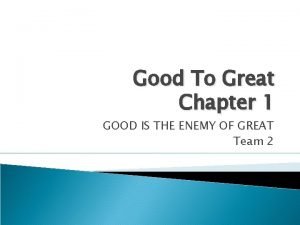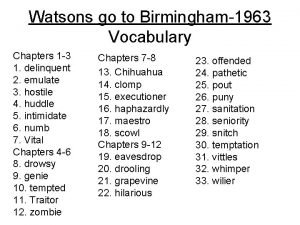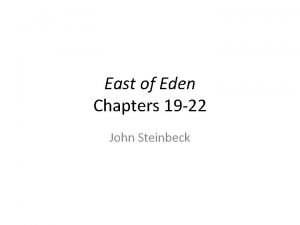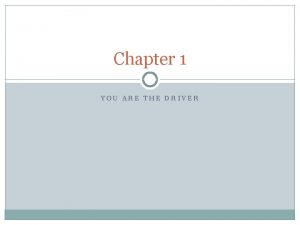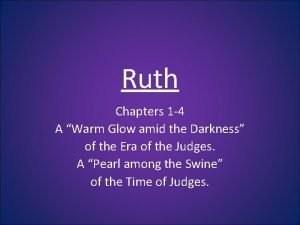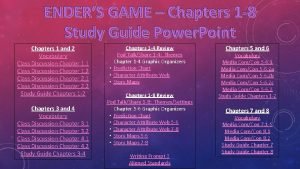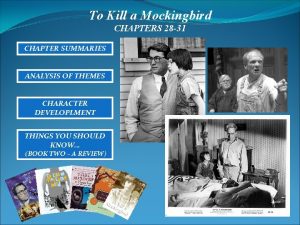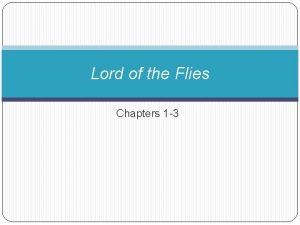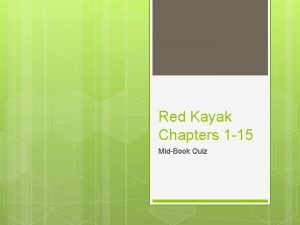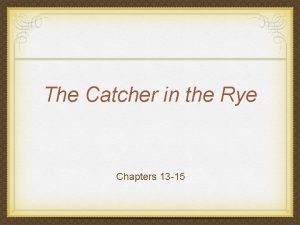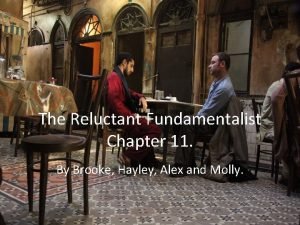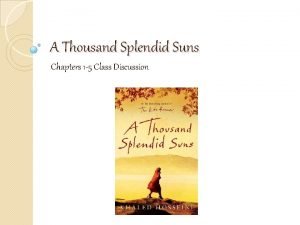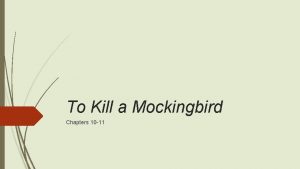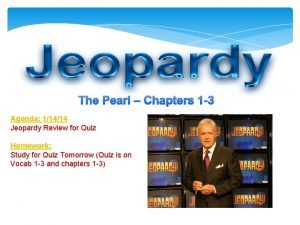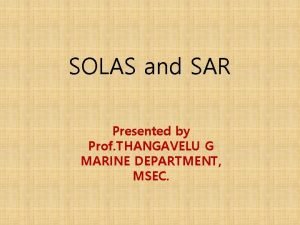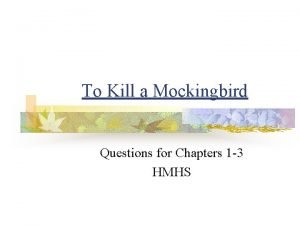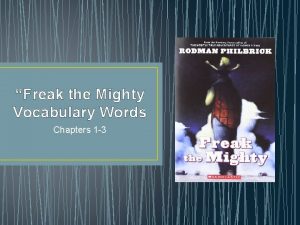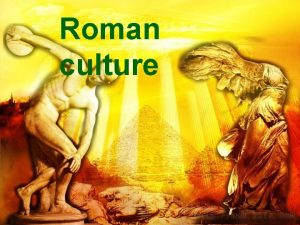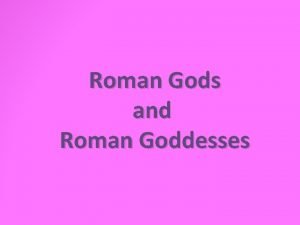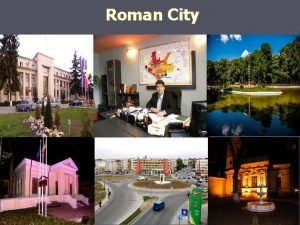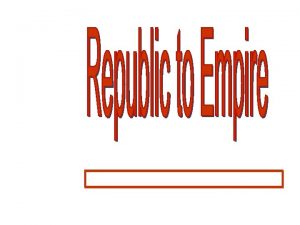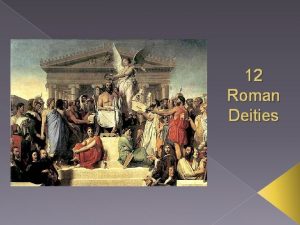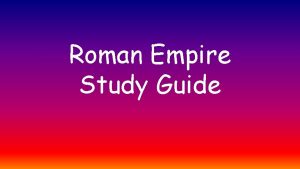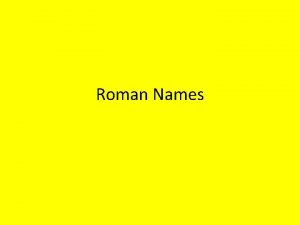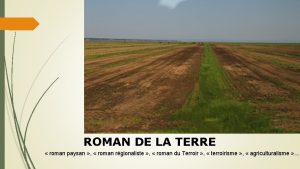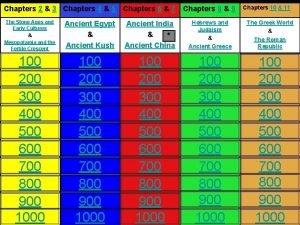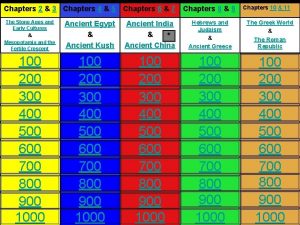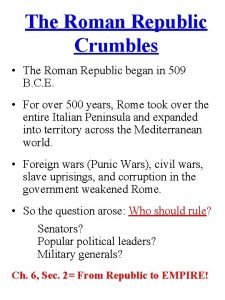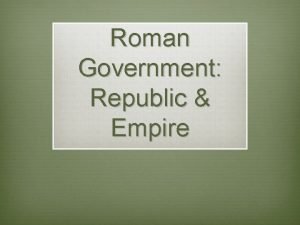Chapters 12 13 Chapters 14 15 The Roman
























































































































- Slides: 120

Chapters 12 & 13 Chapters 14 & 15 The Roman Empire & Rome and Christianity The Fall of Rome & * Early Americas The Fall of Rome & The Rise of Islam The Spread of Islam & Early West African Empires 100 200 300 400 500 600 700 800 900 1000 100 200 300 400 500 600 700 800 900 1000 Chapters 2 & 3 Chapters 4 & 5 Chapter 6

G 6 Chapter 12 The Roman Empire (50 BC – AD 150)

G 6 Chapter 13 Rome and Christianity (AD 1 – 400)

G 6 C 12 Key Terms and People 1. 2. 3. 4. 5. 6. 7. 8. 9. 10. 11. 12. 13. 14. 15. Cicero orator Julius Caesar Pompey Brutus Marc Anthony Augustus Cleopatra Hadrian provinces currency Pax Romana villas Galen aqueduct 16. 17. 18. 19. 20. 21. vault Virgil Ovid satire Romance languages civil law

G 6 C 13 Key Terms and People 1. Christianity 2. Jesus of Nazareth 3. Messiah 4. John the Baptist 5. Bible 6. crucifixion 7. Resurrection 8. disciples 9. Apostles 10. Paul 11. saint 12. matyrs 13. persecution 14. bishops 15. Eucharist 16. 17. Pope Augustine of Hippo 18. Constantine

100 Answer When did he live? 63 BC–AD 14 Where did he live? Rome What did he do? As the leader of Rome, he made many improvements in the city. He created a fire department and a police force to protect the city’s people. He built new aqueducts and repaired old ones to increase Rome’s water supply. He also worked on improving and expanding Rome’s road network. Why is he important? As Rome’s first emperor, he is one of the most significant figures in Roman history. Almost singlehandedly, he changed the nature of Roman government forever. But he is also known for the great monuments he had built around Rome. He built a new forum that held statues, monuments, and a great temple to the god Mars. In writing about his life, he wrote, “I found Rome a city of brick and left it a city of marble. ” 1. 2. 3. 4. 5. 6. 7. Julius Caesar Cleopatra Augustus Roman Trade Routes, AD 200 Roman Roads Roman Arch Civil Law 8. Romans Allow Many Religions 9. Jews and Romans Clash 10. Messiah 11. Bible 12. Jesus of Nazreth 13. Jesus’s Message 14. Constantine

200 1. 2. 3. 4. 5. 6. 7. Answer a legal system based on a written code of laws, like the one created by the Romans. Most countries in Europe today have ________ traditions. In the 1500 s and 1600 s, European explorers and colonists carried ______ around the world. As a result, some countries in Africa, Asia, and the Americas developed these rulse as well. Julius Caesar Cleopatra Augustus Roman Trade Routes, AD 200 Roman Roads Roman Arch Civil Law 8. Romans Allow Many Religions 9. Jews and Romans Clash 10. Messiah 11. Bible 12. Jesus of Nazreth 13. Jesus’s Message 14. Constantine

300 Answer The Romans practiced polytheism in the early years of its empire. When Rome conquered new people, they continued to let them practice their own religion. 1. 2. 3. 4. 5. 6. 7. Julius Caesar Cleopatra Augustus Roman Trade Routes, AD 200 Roman Roads Roman Arch Civil Law 8. Romans Allow Many Religions 9. Jews and Romans Clash 10. Messiah 11. Bible 12. Jesus of Nazreth 13. Jesus’s Message 14. Constantine

400 Answer A network so large and well constructed that parts of it remain today, roughly 2, 000 years later 1. 2. 3. 4. 5. 6. 7. Julius Caesar Cleopatra Augustus Roman Trade Routes, AD 200 Roman Roads Roman Arch Civil Law 8. Romans Allow Many Religions 9. Jews and Romans Clash 10. Messiah 11. Bible 12. Jesus of Nazreth 13. Jesus’s Message 14. Constantine

500 Answer the holy book of Christianity 1. 2. 3. 4. 5. 6. 7. Julius Caesar Cleopatra Augustus Roman Trade Routes, AD 200 Roman Roads Roman Arch Civil Law 8. Romans Allow Many Religions 9. Jews and Romans Clash 10. Messiah 11. Bible 12. Jesus of Nazreth 13. Jesus’s Message 14. Constantine

600 Answer He was probably the greatest general in Roman history. Other Romans admired him for his bravery and skill in battle. At the same time, his soldiers respected him because he treated them well Between 58 and 50 BC he conquered nearly all of Gaul—a region that included much of modern France, Germany, and northern Italy—and part of Britain. After years of traveling and war, he returned to Rome. When he got there, he forced the Senate to name him dictator for 10 years. Later this term was extended and he became dictator for life. 1. 2. 3. 4. 5. 6. 7. Julius Caesar Cleopatra Augustus Roman Trade Routes, AD 200 Roman Roads Roman Arch Civil Law 8. Romans Allow Many Religions 9. Jews and Romans Clash 10. Messiah 11. Bible 12. Jesus of Nazreth 13. Jesus’s Message 14. Constantine

700 Answer This design supported much heavier weights than other shapes can. It was used in the design of aqueducts and vaults. 1. 2. 3. 4. 5. 6. 7. Julius Caesar Cleopatra Augustus Roman Trade Routes, AD 200 Roman Roads Roman Arch Civil Law 8. Romans Allow Many Religions 9. Jews and Romans Clash 10. Messiah 11. Bible 12. Jesus of Nazreth 13. Jesus’s Message 14. Constantine

800 Answer (c. 280– 337) He grew up in the court of the Roman emperor. As a young man he became a general and led his army in many successful campaigns. After he converted to Christianity, he came to believe that he had been successful all his life because he had God’s favor. He built several great churches in the empire, including one in Jerusalem at the spot where Jesus was believed to have been buried. Throughout history Christians have considered him one of Rome’s greatest emperors. 1. 2. 3. 4. 5. 6. 7. Julius Caesar Cleopatra Augustus Roman Trade Routes, AD 200 Roman Roads Roman Arch Civil Law 8. Romans Allow Many Religions 9. Jews and Romans Clash 10. Messiah 11. Bible 12. Jesus of Nazreth 13. Jesus’s Message 14. Constantine

900 Answer He was the Messiah and the son of God. 1. 2. 3. 4. 5. 6. 7. Julius Caesar Cleopatra Augustus Roman Trade Routes, AD 200 Roman Roads Roman Arch Civil Law 8. Romans Allow Many Religions 9. Jews and Romans Clash 10. Messiah 11. Bible 12. Jesus of Nazreth 13. Jesus’s Message 14. Constantine

1000 Answer Political conflict arose because the Jews rebelled against Roman rule. Judea, the territory in which most Jews lived, had been conquered by Rome in 63 BC. Since then, many Jews had been unhappy with Roman rule. They wanted to be ruled only by Jews, not by outsiders. As a result, the Jews rebelled in the AD 60 s. The rebellion was defeated, however, and the Jews were punished for their actions. 1. 2. 3. 4. 5. 6. 7. Julius Caesar Cleopatra Augustus Roman Trade Routes, AD 200 Roman Roads Roman Arch Civil Law 8. Romans Allow Many Religions 9. Jews and Romans Clash 10. Messiah 11. Bible 12. Jesus of Nazreth 13. Jesus’s Message 14. Constantine

G 6 Chapter 14 The Fall of Rome (220 – 1453)

G 6 Chapter 15 Early Americas (12, 000 BC – AD 900)

G 6 C 14 Key Terms and People 1. 2. 3. 4. 5. 6. 7. 8. Diocletian Clovis Attila corruption Justinian Theodora Byzantine Empire mosaics

G 6 C 15 Key Terms and People 1. 2. 3. 4. 5. 6. Mesoamerica maize obsidian Pacal observatories Popol Vuh

100 Answer Problems Inside the Empire – large size made communication difficult, corruption became common, rich citizens left Rome for country estates, taxes and prices rose; Problems Outside of the Empire – barbarians began invading the empire 1. 2. 3. 4. 5. 6. 7. The Goths 8. Maize Why Rome Fell? 9. Obsidian The Byzantine Empire 10. Palenque The Western Roman and Byzantine Empires 11. Warfare The Glory of Constantinople 12. Upper Class vs. Lower Class Theodora 13. A Maya King and His Court Justinian 14. Religion

200 Answer The capital, Constantinople, was strategically located where Europe and Asia meet. As a result, the city was in a perfect location to control trade routes between the two continents. 1. 2. 3. 4. 5. 6. 7. The Goths 8. Maize Why Rome Fell? 9. Obsidian The Byzantine Empire 10. Palenque The Western Roman and Byzantine Empires 11. Warfare The Glory of Constantinople 12. Upper Class vs. Lower Class Theodora 13. A Maya King and His Court Justinian 14. Religion

300 Answer This was a sharp, glasslike volcanic rock, that came from different parts of Mesoamerica. It was used for weapons and cutting tools. It was valued for its sharp edges and considered sacred by the Maya, and it was mined in the mountains and traded throughout the Maya world. 1. 2. 3. 4. 5. 6. 7. The Goths 8. Maize Why Rome Fell? 9. Obsidian The Byzantine Empire 10. Palenque The Western Roman and Byzantine Empires 11. Warfare The Glory of Constantinople 12. Upper Class vs. Lower Class Theodora 13. A Maya King and His Court Justinian 14. Religion

400 Answer Rome’s leaders were afraid that these people would destroy Roman land property. To stop this destruction, the emperors fought to keep them out of Roman lands. In the east the armies were largely successful. They forced them to move farther west. As a result, however, the western armies were defeated by them, who moved into Roman territory. The Romans fought desperately to keep them away from Rome. They also paid them not to attack them. For many years this strategy worked. In 408, however, the Romans stopped making payments. This made them furious. Despite the Romans’ best efforts to defend their city, they sacked, or destroyed, Rome in 410. 1. 2. 3. 4. 5. 6. 7. The Goths 8. Maize Why Rome Fell? 9. Obsidian The Byzantine Empire 10. Palenque The Western Roman and Byzantine Empires 11. Warfare The Glory of Constantinople 12. Upper Class vs. Lower Class Theodora 13. A Maya King and His Court Justinian 14. Religion

500 Answer For one empire, popes and bishops led the church, and the emperor led the government while Latin was the main language. For the other empire, emperors led the church and the government while Greek was the main language. 1. 2. 3. 4. 5. 6. 7. The Goths 8. Maize Why Rome Fell? 9. Obsidian The Byzantine Empire 10. Palenque The Western Roman and Byzantine Empires 11. Warfare The Glory of Constantinople 12. Upper Class vs. Lower Class Theodora 13. A Maya King and His Court Justinian 14. Religion

600 Answer He made Constantinople into a grand capital city and the center of a strong empire. He tried to conquer the former western Roman empire but couldn’t. 1. 2. 3. 4. 5. 6. 7. The Goths 8. Maize Why Rome Fell? 9. Obsidian The Byzantine Empire 10. Palenque The Western Roman and Byzantine Empires 11. Warfare The Glory of Constantinople 12. Upper Class vs. Lower Class Theodora 13. A Maya King and His Court Justinian 14. Religion

700 Answer This is corn. 1. 2. 3. 4. 5. 6. 7. The Goths 8. Maize Why Rome Fell? 9. Obsidian The Byzantine Empire 10. Palenque The Western Roman and Byzantine Empires 11. Warfare The Glory of Constantinople 12. Upper Class vs. Lower Class Theodora 13. A Maya King and His Court Justinian 14. Religion

800 Answer c. 500– 548 She helped create laws to aid women and children and to end government corruption. 1. 2. 3. 4. 5. 6. 7. The Goths 8. Maize Why Rome Fell? 9. Obsidian The Byzantine Empire 10. Palenque The Western Roman and Byzantine Empires 11. Warfare The Glory of Constantinople 12. Upper Class vs. Lower Class Theodora 13. A Maya King and His Court Justinian 14. Religion

900 Answer Maya _______ was bloody. Warriors fought hand-to-hand using spears, flint knives, and wooden clubs. The Maya often captured enemy prisoners and killed them in religious ceremonies as a sacrifice to their gods. They burned enemy towns and villages. ______ probably tore up the land destroyed crops. Maya _______ was so destructive that some scholars think it may have contributed to the end of the Maya civilization. 1. 2. 3. 4. 5. 6. 7. The Goths 8. Maize Why Rome Fell? 9. Obsidian The Byzantine Empire 10. Palenque The Western Roman and Byzantine Empires 11. Warfare The Glory of Constantinople 12. Upper Class vs. Lower Class Theodora 13. A Maya King and His Court Justinian 14. Religion

1000 Answer The king held the highest position in society. Priests, warriors, and merchants were also part of the privileged. Rulers were believed to be related to gods. Most Mayans were farmers and lived in small houses outside the cities. 1. 2. 3. 4. 5. 6. 7. The Goths 8. Maize Why Rome Fell? 9. Obsidian The Byzantine Empire 10. Palenque The Western Roman and Byzantine Empires 11. Warfare The Glory of Constantinople 12. Upper Class vs. Lower Class Theodora 13. A Maya King and His Court Justinian 14. Religion

G 7 Chapter 2 The Fall of Rome (AD 117 -1453)

G 7 Chapter 3 The Rise of Islam (AD 550 -650)

G 7 C 2 Key Terms and People 1. Augustus 2. citizens 3. aqueducts 4. Diocletian 5. Constantine 6. Clovis 7. Attila 8. corruption 9. Justinian 10. Theodora 11. Byzantine Empire 12. mosaics

G 7 C 3 Key Terms and People 1. 2. 3. 4. 5. 6. 7. 8. 9. 10. 11. 12. 13. 14. 15. sand dunes oasis sedentary caravan souk Muhammad Islam Muslim Qur’an shrine pilgrimage mosque jihad Sunnah Five Pillars of Islam

100 Answer In the 200’s, convinced that the empire was too big for one person to rule, Diocletian divided the empire. He ruled one-half of the empire and named a co-emperor to rule the other half. 1. 2. 3. 4. 5. 6. 7. The Legacy of Rome Early Christianity in the Roman Empire The Eastern and Western Empires Invasions of the Roman Empire Why Rome Fell? The Byzantine Empire The Glory of Constantinople 8. Nomads 9. Muhammad’s Teachings 10. Judaism 11. Christianity 12. Islam 13. The Five Pillars of Islam 14. Sources of Islamic Beliefs

200 Answer • Qur’an - Holy book that includes all the messages Muhammad received from God • Sunnah - Muhammad’s example for the duties and way of life expected of Muslims • Shariah - Islamic law, based on interpretations of the Qur’an and Sunnah 1. 2. 3. 4. 5. 6. 7. The Legacy of Rome Early Christianity in the Roman Empire The Eastern and Western Empires Invasions of the Roman Empire Why Rome Fell? The Byzantine Empire The Glory of Constantinople 8. Nomads 9. Muhammad’s Teachings 10. Judaism 11. Christianity 12. Islam 13. The Five Pillars of Islam 14. Sources of Islamic Beliefs

300 Answer This religion uses the Torah for its holy book of learning. 1. 2. 3. 4. 5. 6. 7. The Legacy of Rome Early Christianity in the Roman Empire The Eastern and Western Empires Invasions of the Roman Empire Why Rome Fell? The Byzantine Empire The Glory of Constantinople 8. Nomads 9. Muhammad’s Teachings 10. Judaism 11. Christianity 12. Islam 13. The Five Pillars of Islam 14. Sources of Islamic Beliefs

400 Answer This religion uses the Bible for its holy book of learning. 1. 2. 3. 4. 5. 6. 7. The Legacy of Rome Early Christianity in the Roman Empire The Eastern and Western Empires Invasions of the Roman Empire Why Rome Fell? The Byzantine Empire The Glory of Constantinople 8. Nomads 9. Muhammad’s Teachings 10. Judaism 11. Christianity 12. Islam 13. The Five Pillars of Islam 14. Sources of Islamic Beliefs

500 Answer This religion uses the Qur’an for its holy book of learning. 1. 2. 3. 4. 5. 6. 7. The Legacy of Rome Early Christianity in the Roman Empire The Eastern and Western Empires Invasions of the Roman Empire Why Rome Fell? The Byzantine Empire The Glory of Constantinople 8. Nomads 9. Muhammad’s Teachings 10. Judaism 11. Christianity 12. Islam 13. The Five Pillars of Islam 14. Sources of Islamic Beliefs

600 Answer These people constantly traveled and traded goods throughout the desert. 1. 2. 3. 4. 5. 6. 7. The Legacy of Rome Early Christianity in the Roman Empire The Eastern and Western Empires Invasions of the Roman Empire Why Rome Fell? The Byzantine Empire The Glory of Constantinople 8. Nomads 9. Muhammad’s Teachings 10. Judaism 11. Christianity 12. Islam 13. The Five Pillars of Islam 14. Sources of Islamic Beliefs

700 Answer The idea of writing down laws and a having a separation of powers for a government. The use of roads to connect cities to provide accessible trading routes. Buildings that continue to use the pillar design for architectural features. 1. 2. 3. 4. 5. 6. 7. The Legacy of Rome Early Christianity in the Roman Empire The Eastern and Western Empires Invasions of the Roman Empire Why Rome Fell? The Byzantine Empire The Glory of Constantinople 8. Nomads 9. Muhammad’s Teachings 10. Judaism 11. Christianity 12. Islam 13. The Five Pillars of Islam 14. Sources of Islamic Beliefs

800 Answer Problems Inside the Empire 1. Large size made communication difficult. 2. Corruption became common. 3. Rich citizens left Rome for country estates. 4. Taxes and prices rose. Problems Outside the Empire 1. Barbarians began invading the empire. 1. 2. 3. 4. 5. 6. 7. The Legacy of Rome Early Christianity in the Roman Empire The Eastern and Western Empires Invasions of the Roman Empire Why Rome Fell? The Byzantine Empire The Glory of Constantinople 8. Nomads 9. Muhammad’s Teachings 10. Judaism 11. Christianity 12. Islam 13. The Five Pillars of Islam 14. Sources of Islamic Beliefs

900 Answer The Romans fought desperately to keep the Goths away from Rome. They also paid the Goths not to attack them. For many years this strategy worked. In 408, however, the Romans stopped making payments. This made the Goths furious. Despite the Romans’ best efforts to defend their city, the Goths sacked, or destroyed, Rome in 410. The destruction of Rome absolutely devastated the Romans. No one had attacked their city in nearly 800 years. For the first time, many Romans began to feel afraid for the safety of their empire. 1. 2. 3. 4. 5. 6. 7. The Legacy of Rome Early Christianity in the Roman Empire The Eastern and Western Empires Invasions of the Roman Empire Why Rome Fell? The Byzantine Empire The Glory of Constantinople 8. Nomads 9. Muhammad’s Teachings 10. Judaism 11. Christianity 12. Islam 13. The Five Pillars of Islam 14. Sources of Islamic Beliefs

1000 Answer Muhammad became a prophet and introduced a religion called Islam in Arabia. _________ had similarities to Judaism and Christianity, but they also presented new ideas. He taught to believe in one God and should give money to help the poor. 1. 2. 3. 4. 5. 6. 7. The Legacy of Rome Early Christianity in the Roman Empire The Eastern and Western Empires Invasions of the Roman Empire Why Rome Fell? The Byzantine Empire The Glory of Constantinople 8. Nomads 9. Muhammad’s Teachings 10. Judaism 11. Christianity 12. Islam 13. The Five Pillars of Islam 14. Sources of Islamic Beliefs

G 7 Chapter 4 The Spread of Islam (AD 634 -1650)

G 7 Chapter 5 Early West African Societies (3000 BC – AD 300)

G 7 C 4 Key Terms and People 1. 2. 3. 4. 5. 6. 7. 8. 9. 10. 11. 12. 13. 14. 15. Abu Bakr caliph tolerance Janissaries Mehmed II sultan Suleyman I harem Shia Sunni Ibn Battutah Sufism Omar Khayyam patrons minaret 16. calligraphy

G 7 C 5 Key Terms and People 1. 2. 3. 4. 5. 6. 7. Rifts sub-Saharan Africa Sahel savannah rain forests extended family animism

100 Answer Covers most of North Africa or about a 1/3 of Africa territory 1. 2. 3. 4. 5. 6. 7. Trade in the Muslim World The City of Corboda The Hajj The Ottoman Empire The Safavid Empire The Mughal Empire Islamic Achievements 8. Desert 9. Savannah 10. Rain Forest 11. Village Society 12. Animism 13. Extended Family 14. Trade in West Africa

200 Answer Much of Africa is covered by grasslands. Also, known as _______. 1. 2. 3. 4. 5. 6. 7. Trade in the Muslim World The City of Corboda The Hajj The Ottoman Empire The Safavid Empire The Mughal Empire Islamic Achievements 8. Desert 9. Savannah 10. Rain Forest 11. Village Society 12. Animism 13. Extended Family 14. Trade in West Africa

300 Answer The Astrolabe Although the Greeks invented the astrolabe, Muslim scholars greatly improved it. Astronomy Muslim scientists made remarkable advances in astronomy. An observatory was built in the 1700 s in Delhi, the capital of Mughal India. Geography Muslims created new and better maps led to even more travel and a greater understanding of the world’s geography. 1. 2. 3. 4. 5. 6. 7. Trade in the Muslim World The City of Corboda The Hajj The Ottoman Empire The Safavid Empire The Mughal Empire Islamic Achievements 8. Desert 9. Savannah 10. Rain Forest 11. Village Society 12. Animism 13. Extended Family 14. Trade in West Africa

400 Answer Was located in Spain, was a great center of Islamic learning. In fact, in the early AD 900 s, it was one of the richest and most educated cities in Europe. ______ was a great center of learning. Men and women from across the Muslim world and Europe came to study at the university there. They studied Greek and Roman scientific writings and translated them into Arabic. In addition, they studied writings produced in the Muslim world and translated them from Arabic to Latin. As a result, Arabic writings on such subjects as mathematics, medicine, astronomy, geography, and history could be studied throughout Europe. 1. . 2. 3. 4. 5. 6. 7. Trade in the Muslim World The City of Corboda The Hajj The Ottoman Empire The Safavid Empire The Mughal Empire Islamic Achievements 8. Desert 9. Savannah 10. Rain Forest 11. Village Society 12. Animism 13. Extended Family 14. Trade in West Africa

500 Answer The belief that bodies of water, animals, trees, and other natural objects have spirits. ________ reflected West Africans’ dependence on the natural world for survival. 1. 2. 3. 4. 5. 6. 7. Trade in the Muslim World The City of Corboda The Hajj The Ottoman Empire The Safavid Empire The Mughal Empire Islamic Achievements 8. Desert 9. Savannah 10. Rain Forest 11. Village Society 12. Animism 13. Extended Family 14. Trade in West Africa

600 Answer Located in central and western Africa. 1. 2. 3. 4. 5. 6. 7. Trade in the Muslim World The City of Corboda The Hajj The Ottoman Empire The Safavid Empire The Mughal Empire Islamic Achievements 8. Desert 9. Savannah 10. Rain Forest 11. Village Society 12. Animism 13. Extended Family 14. Trade in West Africa

700 Answer In the mid-1200 s Muslim Turkish warriors known as Ottomans began to take land from the Christian Byzantine Empire. They eventually ruled lands from eastern Europe to North Africa and Arabia. The key to the empire’s expansion was the Ottoman army. The Ottomans trained Christian boys from conquered towns to be soldiers. These slave soldiers, called Janissaries, converted to Islam and became fierce fighters. Besides these slave troops, the Ottomans were aided by new gunpowder weapons—especially cannons. 1. 2. 3. 4. 5. 6. 7. Trade in the Muslim World The City of Corboda The Hajj The Ottoman Empire The Safavid Empire The Mughal Empire Islamic Achievements 8. Desert 9. Savannah 10. Rain Forest 11. Village Society 12. Animism 13. Extended Family 14. Trade in West Africa

800 Answer The main items traded were gold and salt. 1. 2. 3. 4. 5. 6. 7. Trade in the Muslim World The City of Corboda The Hajj The Ottoman Empire The Safavid Empire The Mughal Empire Islamic Achievements 8. Desert 9. Savannah 10. Rain Forest 11. Village Society 12. Animism 13. Extended Family 14. Trade in West Africa

900 Answer Every year, as many as 2 million Muslims make a religious journey, or pilgrimage, to Mecca, Saudi Arabia. This journey, called the ______, is one of the Five Pillars of Islam—all Muslims are expected to make the journey at least once in their lifetime if they can. Mecca is the place where Muhammad lived and taught more than 1, 300 years ago. As a result, it is the holiest city in Islam. The pilgrims who travel to Mecca each year serve as a living reminder of the connection between history and geography. 1. 2. 3. 4. 5. 6. 7. Trade in the Muslim World The City of Corboda The Hajj The Ottoman Empire The Safavid Empire The Mughal Empire Islamic Achievements 8. Desert 9. Savannah 10. Rain Forest 11. Village Society 12. Animism 13. Extended Family 14. Trade in West Africa

1000 Answer Families were very large in West Africa. 1. 2. 3. 4. 5. 6. 7. Trade in the Muslim World The City of Corboda The Hajj The Ottoman Empire The Safavid Empire The Mughal Empire Islamic Achievements 8. Desert 9. Savannah 10. Rain Forest 11. Village Society 12. Animism 13. Extended Family 14. Trade in West Africa

G 7 Chapter 6 West African Empires (1000 -1600)

G 7 C 6 Key Terms and People 1. 2. 3. 4. 5. 6. 7. 8. 9. 10. silent barter Tunka Manin Sundiata Mansa Musa Sunni Ali Askia the Great oral history griots proverbs kente

100 Answer a process in which people exchange goods without contacting each other directly 1. 2. 3. 4. 5. 6. 7. Ghana Empire Silent Barter Overgrazing Mali Empire Mansa Musa Songhai Empire Oral Tradition

200 Answer Most traditions in Africa have been passed down by word of mouth. The people of West Africa left no written histories of their own. Visitors to West Africa from other parts of the world, however, did write about the region. Much of what we know about early West Africa comes from the writings of travelers and scholars from Muslim lands such as Spain and Arabia. 1. 2. 3. 4. 5. 6. 7. Ghana Empire Silent Barter Overgrazing Mali Empire Mansa Musa Songhai Empire Oral Tradition

300 Answer Too many animals grazing in one area can lead to problems, such as the loss of farmland that occurred in West Africa. The 3 step process: 1. Animals are allowed to graze in areas with lots of grass. 2. With too many animals grazing, however, the grass disappears, leaving soil below exposed to the wind. 3. The wind blows the soil away, turning what was once grassland into desert. 1. 2. 3. 4. 5. 6. 7. Ghana Empire Silent Barter Overgrazing Mali Empire Mansa Musa Songhai Empire Oral Tradition

400 Answer It controlled the trading routes in West Africa so it was able to build an empire. 1. 2. 3. 4. 5. 6. 7. Ghana Empire Silent Barter Overgrazing Mali Empire Mansa Musa Songhai Empire Oral Tradition

500 Answer Mali’s greatest and most famous ruler, he was a devout Muslim. He made a famous pilgrimage to Mecca that helped spread Mali’s fame. 1. 2. 3. 4. 5. 6. 7. Ghana Empire Silent Barter Overgrazing Mali Empire Mansa Musa Songhai Empire Oral Tradition

600 Answer c. 1500 1. The ______ built a new empire in West Africa. 2. Askia the Great ruled this empire as an Islamic empire. 3. The empire fell to Moroccan invaders, ending the great era of West African empires. 1. 2. 3. 4. 5. 6. 7. Ghana Empire Silent Barter Overgrazing Mali Empire Mansa Musa Songhai Empire Oral Tradition

700 Answer c. 1300 The leader of the ______, Sundiata, conquered all neighboring enemies and had new agricultural methods introduced such as growing beans, onions, rice, and cotton. He held all power. 1. 2. 3. 4. 5. 6. 7. Ghana Empire Silent Barter Overgrazing Mali Empire Mansa Musa Songhai Empire Oral Tradition

800 Answer a process in which people exchange goods without contacting each other directly 1. 2. 3. 4. 5. 6. 7. Ghana Empire Silent Barter Overgrazing Mali Empire Mansa Musa Songhai Empire Oral Tradition

900 Answer Most traditions in Africa have been passed down by word of mouth. The people of West Africa left no written histories of their own. Visitors to West Africa from other parts of the world, however, did write about the region. Much of what we know about early West Africa comes from the writings of travelers and scholars from Muslim lands such as Spain and Arabia. 1. 2. 3. 4. 5. 6. 7. Ghana Empire Silent Barter Overgrazing Mali Empire Mansa Musa Songhai Empire Oral Tradition

1000 Answer Too many animals grazing in one area can lead to problems, such as the loss of farmland that occurred in West Africa. The 3 step process: 1. Animals are allowed to graze in areas with lots of grass. 2. With too many animals grazing, however, the grass disappears, leaving soil below exposed to the wind. 3. The wind blows the soil away, turning what was once grassland into desert. 1. 2. 3. 4. 5. 6. 7. Ghana Empire Silent Barter Overgrazing Mali Empire Mansa Musa Songhai Empire Oral Tradition

Chapters 12 & 13 Chapters 14 & 15 The Roman Empire & Rome and Christianity The Fall of Rome & * Early Americas The Fall of Rome & The Rise of Islam The Spread of Islam & Early West African Empires 100 - 3 200 - 7 300 - 8 400 - 5 100 - 2 200 - 3 300 - 9 400 - 1 100 - 3 200 - 14 300 - 10 400 - 11 100 - 8 200 - 9 300 - 7 400 - 2 100 - 2 200 - 7 300 - 3 400 - 1 500 - 11 600 - 1 500 - 4 600 - 7 500 - 12 600 - 8 500 - 12 600 - 10 500 - 5 600 - 6 700 - 6 800 - 14 700 - 8 800 - 6 700 - 1 800 - 5 700 - 4 800 - 14 700 - 4 800 - 2 900 - 12 1000 - 9 900 - 11 1000 - 12 900 - 4 1000 - 9 900 - 3 1000 - 13 900 - 7 1000 - 3 Chapters 2 & 3 Chapters 4 & 5 Chapter 6

100 3. Augustus

200 7. Civil Law

300 8. Romans Allow Many Religions

400 5. Roman Roads

500 11. Bible

600 1. Julius Ceasar

700 6. The Roman Arch

800 14. Constantine

900 12. Jesus of Nazareth

1000 9. Jews and Romans Clash

100 2. Why Rome Fell

200 3. The Byzantine Empire

300 9. Obsidian

400 1. The Goths

500 4. The Western Roman and Byzantine Empire

600 7. Justinian

700 8. maize

800 6. Theodora

900 11. Warfare

1000 12. Upper Class vs. Lower Class

100 3. The Eastern and Western Empires

200 14. Sources of Islamic Beliefs

300 10. Judaism

400 11. Christianity

500 12. Islam

600 8. Nomads

700 1. The Legacy of Rome

800 5. Why Rome Fell?

900 4. Invasions of the Roman Empire

1000 9. Muhammad’s Teachings

100 8. Desert

200 9. Savannah

300 7. Islamic Achievements

400 2. The City of Cordoba

500 12. Animism

600 10. Rain Forest

700 4. The Ottoman Empire

800 14. Trade in West Africa

900 3. The Hajj

1000 13. Extended Family

100 2. Silent Barter

200 7. Oral Tradition

300 3. Overgrazing

400 1. Ghana Empire

500 5. Mansa Musa

600 6. Songhai Empire

700 4. Mali Empire

800 2. Silent Barter

900 7. Oral Tradition

1000 3. Overgrazing
 Difference between roman republic and roman empire
Difference between roman republic and roman empire Roman republic vs roman empire
Roman republic vs roman empire Cách giải mật thư tọa độ
Cách giải mật thư tọa độ Lời thề hippocrates
Lời thề hippocrates Vẽ hình chiếu đứng bằng cạnh của vật thể
Vẽ hình chiếu đứng bằng cạnh của vật thể Tư thế worms-breton
Tư thế worms-breton Quá trình desamine hóa có thể tạo ra
Quá trình desamine hóa có thể tạo ra Sự nuôi và dạy con của hươu
Sự nuôi và dạy con của hươu Các châu lục và đại dương trên thế giới
Các châu lục và đại dương trên thế giới Dot
Dot Bổ thể
Bổ thể Biện pháp chống mỏi cơ
Biện pháp chống mỏi cơ độ dài liên kết
độ dài liên kết Thiếu nhi thế giới liên hoan
Thiếu nhi thế giới liên hoan Fecboak
Fecboak Hát lên người ơi alleluia
Hát lên người ơi alleluia điện thế nghỉ
điện thế nghỉ Một số thể thơ truyền thống
Một số thể thơ truyền thống Sơ đồ cơ thể người
Sơ đồ cơ thể người Công thức tiính động năng
Công thức tiính động năng Các số nguyên tố
Các số nguyên tố đặc điểm cơ thể của người tối cổ
đặc điểm cơ thể của người tối cổ Tỉ lệ cơ thể trẻ em
Tỉ lệ cơ thể trẻ em Các châu lục và đại dương trên thế giới
Các châu lục và đại dương trên thế giới ưu thế lai là gì
ưu thế lai là gì Thẻ vin
Thẻ vin Các môn thể thao bắt đầu bằng tiếng bóng
Các môn thể thao bắt đầu bằng tiếng bóng Tư thế ngồi viết
Tư thế ngồi viết Bàn tay mà dây bẩn
Bàn tay mà dây bẩn Hát kết hợp bộ gõ cơ thể
Hát kết hợp bộ gõ cơ thể Từ ngữ thể hiện lòng nhân hậu
Từ ngữ thể hiện lòng nhân hậu Trời xanh đây là của chúng ta thể thơ
Trời xanh đây là của chúng ta thể thơ Tư thế ngồi viết
Tư thế ngồi viết V cc cc
V cc cc Chó sói
Chó sói Thể thơ truyền thống
Thể thơ truyền thống Hươu thường đẻ mỗi lứa mấy con
Hươu thường đẻ mỗi lứa mấy con Thế nào là hệ số cao nhất
Thế nào là hệ số cao nhất Diễn thế sinh thái là
Diễn thế sinh thái là đại từ thay thế
đại từ thay thế Vẽ hình chiếu vuông góc của vật thể sau
Vẽ hình chiếu vuông góc của vật thể sau Làm thế nào để 102-1=99
Làm thế nào để 102-1=99 Thế nào là mạng điện lắp đặt kiểu nổi
Thế nào là mạng điện lắp đặt kiểu nổi Nonviolent communication chapters
Nonviolent communication chapters Night discussion questions chapter 4
Night discussion questions chapter 4 Chapter 22 never let me go
Chapter 22 never let me go Noughts and crosses sex scene
Noughts and crosses sex scene Metacommentary templates
Metacommentary templates Genesis 6:9-22
Genesis 6:9-22 11 step marketing research process
11 step marketing research process When things fall apart quotes
When things fall apart quotes East of eden chapters
East of eden chapters Main idea and supporting details definition
Main idea and supporting details definition How to kill a mockingbird summary chapter 2
How to kill a mockingbird summary chapter 2 Scarlet letter chapter 12 summary
Scarlet letter chapter 12 summary Tkam chapter 1-5 summary
Tkam chapter 1-5 summary Candide chapter summaries
Candide chapter summaries Animal farm chapter 9 and 10 summary
Animal farm chapter 9 and 10 summary Chapter 4-6 summary to kill a mockingbird
Chapter 4-6 summary to kill a mockingbird Fbla-pbl state chapters usually have a number of elected
Fbla-pbl state chapters usually have a number of elected Hatchet vocabulary
Hatchet vocabulary How many chapters are in copper sun
How many chapters are in copper sun Deadlock summary by chapters
Deadlock summary by chapters Summary of chapters 4-6 lord of the flies
Summary of chapters 4-6 lord of the flies Great gatsby nick appearance
Great gatsby nick appearance Summary chapter 4 great gatsby
Summary chapter 4 great gatsby Pda chapters
Pda chapters Miss maudie atkinson quotes chapters 4-6
Miss maudie atkinson quotes chapters 4-6 Chapter 9 lord of the flies
Chapter 9 lord of the flies Sparknotes scarlet letter chapter 11
Sparknotes scarlet letter chapter 11 Chapters 4-7 to kill a mockingbird summary
Chapters 4-7 to kill a mockingbird summary Themes in wuthering heights
Themes in wuthering heights To kill a mockingbird resume by chapter
To kill a mockingbird resume by chapter Chapter 15 of the scarlet letter
Chapter 15 of the scarlet letter Ecumential
Ecumential Ashtanga hridaya 11th chapter
Ashtanga hridaya 11th chapter Frankenstein chapter 10-11 summary
Frankenstein chapter 10-11 summary To kill a mockingbird chapter 1 quiz
To kill a mockingbird chapter 1 quiz Comment on aunt alexandra's ideas about breeding and family
Comment on aunt alexandra's ideas about breeding and family Good to great chapter 3
Good to great chapter 3 The watsons go to birmingham vocabulary
The watsons go to birmingham vocabulary Distraught definition the giver
Distraught definition the giver Full gospel businessmen fellowship international ghana
Full gospel businessmen fellowship international ghana Biomedical waste management nabh
Biomedical waste management nabh Frankenstein mary shelley chapter summaries
Frankenstein mary shelley chapter summaries East of eden chapter 19
East of eden chapter 19 The hunger games chapter 23
The hunger games chapter 23 Chapter 1 you are the driver answers
Chapter 1 you are the driver answers The scarlet letter vocabulary chapters 1-4
The scarlet letter vocabulary chapters 1-4 Ruth chapters 1-4
Ruth chapters 1-4 Chapter 16 things fall apart
Chapter 16 things fall apart To kill a mockingbird chapter 9-11 summary
To kill a mockingbird chapter 9-11 summary Obstreperous definition to kill a mockingbird
Obstreperous definition to kill a mockingbird How many chapters in enders game
How many chapters in enders game They say i say chapters
They say i say chapters Brave new world chapters 4-6
Brave new world chapters 4-6 Analytical chemistry chapters
Analytical chemistry chapters To kill a mockingbird 28-31 summary
To kill a mockingbird 28-31 summary Overdrive chapters locked
Overdrive chapters locked The boy with the fair hair lowered himself
The boy with the fair hair lowered himself Charlie and the chocolate factory chapters
Charlie and the chocolate factory chapters General physics 1 measurements
General physics 1 measurements Red kayak chapter 14 summary
Red kayak chapter 14 summary Who killed glaurung
Who killed glaurung Holden and sunny
Holden and sunny Things fall apart chapter 20-25 summary
Things fall apart chapter 20-25 summary Life of pi chapters 15-28 summary
Life of pi chapters 15-28 summary The reluctant fundamentalist chapter 4
The reluctant fundamentalist chapter 4 To kill a mockingbird 12-16 summary
To kill a mockingbird 12-16 summary A thousand splendid suns summary chapter 1
A thousand splendid suns summary chapter 1 The boy in the striped pajamas vocabulary words
The boy in the striped pajamas vocabulary words To kill a mockingbird 10-11 summary
To kill a mockingbird 10-11 summary The pearl vocabulary chapters 1-3
The pearl vocabulary chapters 1-3 Chapter 7 never let me go
Chapter 7 never let me go Solas all chapters
Solas all chapters Chapter 4 standardized test practice answers
Chapter 4 standardized test practice answers To kill a mockingbird questions
To kill a mockingbird questions Freak the mighty vocabulary chapters 1-5
Freak the mighty vocabulary chapters 1-5 Chapter 1 dracula analysis
Chapter 1 dracula analysis Plot of flowers for algernon
Plot of flowers for algernon

